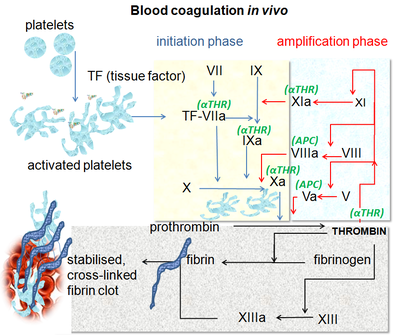Coagulation
A coagulation, also known as clot, is a semi-solid substance blood forms on purpose to stop a leak. Blood does this especially when it is in air. When a person bleeds, the blood turns into a clot at the site of injury so no more blood can escape.
A blood clot called a thrombus is one example of a blood clot.
The clotting process is called coagulation.
If a person gets a cut on their body, they will bleed. To stop the bleeding, the human body first tells the liver to produce chemicals that will help the clot to form, the message coming from the brain. When the chemicals released by the liver arrive at the injury through the circulation, coagulation begins. At the same time, the brain also lessens the blood flow near the site of injury (by tightening the veins and arteries in that area), so that not as much blood is lost.
There is a limit to how quickly a clot can form. If the cut is very deep and the person is bleeding too much, a clot may not be able to form and a lot of blood may be lost. Losing too much blood too quickly can be fatal. In medical emergencies where the blood circulation needs to be temporarily stopped (like to prevent death by hypovolaemia) they might use a Tourniquet on the limb if they can.
The details[change | change source]

Coagulation begins almost instantly after an injury to the blood vessel has damaged the endothelium lining the vessel. When blood is exposed to proteins such as tissue factor it starts changes to blood platelets and the plasma protein fibrinogen, which is a clotting factor. Platelets immediately form a plug at the site of injury. Proteins in the blood plasma, called coagulation factors or clotting factors, respond in a complex cascade to form fibrin strands. These strengthen the platelet plug.[1]
Coagulation is highly conserved throughout biology; that means its genetics is almost the same in all species of mammal. In all mammals, coagulation involves both a cellular (platelet) and a protein (coagulation factor) component.[2] The system in humans has been the most extensively researched and is the best understood.[3]
Fibrin[change | change source]
Fibrin is a white insoluble fibrous protein formed by the action of thrombin on fibrinogen when blood clots. it forms a network that traps red cells and platelets.
Vitamin K[change | change source]
Vitamin K is an essential factor in blood clotting. Then, vitamin K is oxidized. Another enzyme, Vitamin K epoxide reductase, (VKORC) reduces vitamin K back to its active form. This reactivation is important as a target of anticoagulant drug warfarin.[4] Vitamin K can be found in green vegetables, such as spinach, lettuce, broccoli or cabbage.
Related pages[change | change source]
References[change | change source]
- ↑ Furie B. & Furie B.C. 2005 (2005). "Thrombus formation in vivo". J. Clin. Invest. 115 (12): 3355–62. doi:10.1172/JCI26987. PMC 1297262. PMID 16322780.
{{cite journal}}: CS1 maint: numeric names: authors list (link) - ↑ Michelson, Alan D. 2006 (29 August 2011). Platelets. Academic Press. pp. 3–5. ISBN 978-0-12-369367-9. Retrieved 18 October 2012.
{{cite book}}: CS1 maint: numeric names: authors list (link) - ↑ Lillicrap, David et al 2009 (2009). Practical hemostasis and thrombosis. Wiley-Blackwell. pp. 1–5. ISBN 978-1-4051-8460-1.
{{cite book}}: CS1 maint: numeric names: authors list (link) - ↑ Anderson J, Young L. "Fat-soluble vitamins". Colorado State University, Cooperative Extension. Archived from the original on 2007-05-17. Retrieved 2020-04-25.
